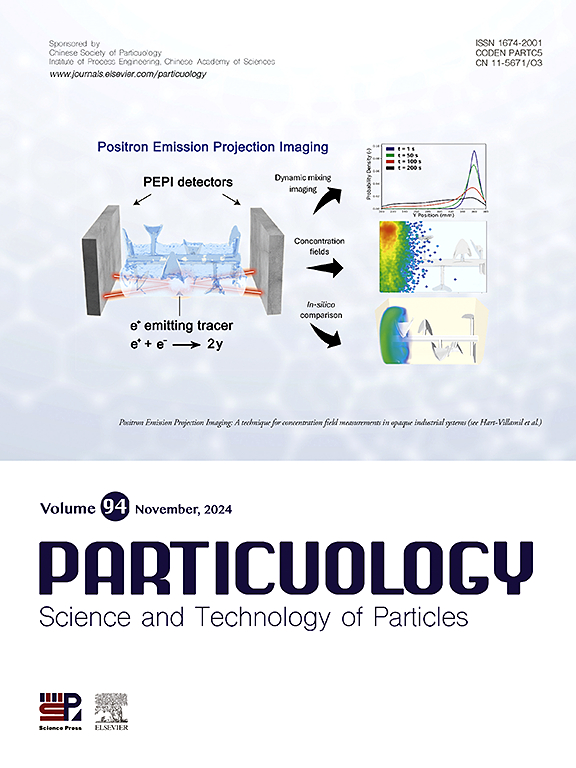Numerical study on the settlement of two parallel spherical particles in upward flow
IF 4.1
2区 材料科学
Q2 ENGINEERING, CHEMICAL
引用次数: 0
Abstract
The settling of particles in fluid flows is a common occurrence in various industrial processes. Investigating the interactions between particles and fluid during settling holds significant importance. This article presents a numerical study of the settling process involving two parallel particles in upward flow, employing the immersed boundary method (IBM). The simulation data were validated using experimental results for single spherical particle settlement, two parallel spherical particles settlement, and the settlement of two series of spherical particles. A comparative analysis was conducted between particle settling in upward flow and static fluid. The study explores the impact of different upward velocities and initial particle spacing on particle settling. Results indicate that the wake generated by the two parallel particles in upward flow forms a distinct boundary with the surrounding fluid. As the upward velocity increases, this boundary becomes increasingly observable. In comparison to settling in static flow, the repulsive effect between two parallel particles in upward flow is stronger, and the settling velocity of particles is smaller. Furthermore, the study reveals that the repulsion between two particles diminishes rapidly with an increase in the initial spacing, but the final settling velocity of particles remains nearly constant.

两个平行球形颗粒在向上流动中沉降的数值研究
颗粒在流体流动中的沉降是各种工业过程中常见的现象。研究沉降过程中颗粒与流体之间的相互作用具有重要意义。本文采用浸入边界法对两个平行颗粒在向上流动中的沉降过程进行了数值研究。通过单球粒沉降、双平行球粒沉降和两串球粒沉降的实验结果对模拟数据进行了验证。对颗粒在向上流动和静态流体中的沉降进行了对比分析。研究了不同的上升速度和初始颗粒间距对颗粒沉降的影响。结果表明,两个平行粒子在向上流动时产生的尾迹与周围流体形成明显的边界。随着向上速度的增加,这个边界变得越来越明显。与静态沉降相比,向上流动时两个平行颗粒之间的排斥力更强,颗粒的沉降速度更小。此外,研究表明,随着初始间距的增加,两粒子之间的斥力迅速减小,但粒子的最终沉降速度几乎保持不变。
本文章由计算机程序翻译,如有差异,请以英文原文为准。
求助全文
约1分钟内获得全文
求助全文
来源期刊

Particuology
工程技术-材料科学:综合
CiteScore
6.70
自引率
2.90%
发文量
1730
审稿时长
32 days
期刊介绍:
The word ‘particuology’ was coined to parallel the discipline for the science and technology of particles.
Particuology is an interdisciplinary journal that publishes frontier research articles and critical reviews on the discovery, formulation and engineering of particulate materials, processes and systems. It especially welcomes contributions utilising advanced theoretical, modelling and measurement methods to enable the discovery and creation of new particulate materials, and the manufacturing of functional particulate-based products, such as sensors.
Papers are handled by Thematic Editors who oversee contributions from specific subject fields. These fields are classified into: Particle Synthesis and Modification; Particle Characterization and Measurement; Granular Systems and Bulk Solids Technology; Fluidization and Particle-Fluid Systems; Aerosols; and Applications of Particle Technology.
Key topics concerning the creation and processing of particulates include:
-Modelling and simulation of particle formation, collective behaviour of particles and systems for particle production over a broad spectrum of length scales
-Mining of experimental data for particle synthesis and surface properties to facilitate the creation of new materials and processes
-Particle design and preparation including controlled response and sensing functionalities in formation, delivery systems and biological systems, etc.
-Experimental and computational methods for visualization and analysis of particulate system.
These topics are broadly relevant to the production of materials, pharmaceuticals and food, and to the conversion of energy resources to fuels and protection of the environment.
 求助内容:
求助内容: 应助结果提醒方式:
应助结果提醒方式:


